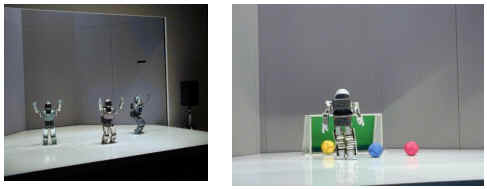 设为首页
设为首页
 加入收藏
加入收藏
扩展资料
Lego Vehicles
There is a kind of Robert. It is
a large number of autonomous Lego vehicles. They are
controlled by 68000 like 'brain bricks', which are programmed
in C, or in a high-level pseudo-parallel language called
CPL developed within the department. The brain bricks
can be connected to Lego motors, as well as a variety
of sensors. Sensors used for teaching vehicles are infrared
range sensors, bumper microswitches, whiskers, light-dependent
resistors, and a hall-effect sensor. Research vehicles
normally include other sensors also.
The use of Lego allows the morphology (shape) of the
vehicle to be changed easily. This allows us to investigate
the relationship between morphology, environment, and
behaviour.
These vehicles are used for research and as part of
our Intelligent Sensing and Control course. Lego robots
built as the practical part of this course participate
in a competition, currently rugby although in previous
years we've done Sumo wrestling instead, or had a `most
interesting robot' competition.

Robots and you
Mrs. Mott invented a memory robot for her husband.
What can other kinds of robots do? Have you seen a robot?
Have you used a robot? What is a robot?
A writer first used the word robot in 1921 in a play.
Since then, many languages use the word robot. A robot
is a machine that does work by itself. Robots do all
kinds of work for people. They can make plastic food
boxes, put a box around ice cream, or even make a watch.
Most robots do not look like people. Most robots stand
still, and have one arm that can do different kinds
of work. The arm can lift and hold things. A robot aim
can use tools. For example, some robots are used to
paint cars. The paint would be dangerous for people,
so the robots paint the cars.
Some robots can move. They have cameras for eyes,
and they can feel with their robot hands. Robots can
be used under the sea to find ships; some robots are
used in space; some robots go into volcanoes where people
cannot go.
Today, robots axe helping doctors; robots are helping
to make highways; robots are helping make tall buildings;
robots are helping people cut grass. What would you
like a robot to do for you?
扩展资料
巧记动词过去式
(一)
be用was或用were, have, has变had.
一般动词加-ed, 若是特殊得硬记。
事情发生在过去,经常、反复或连续。
时间可长也可短,动词时态用“过去”。
(二)
动词一般过去时,表示过去发生事。
谓语动词过去式,过去时间作标志。
否定句很简单,主语之后didn’t添,
疑问句也不难,did放在主语前。
如果谓语之前有did,谓语动词需还原
动词若是was, were,否定就把not添。
扩展资料
怎样写英文日记
写英文日记是促进同学们复习巩固已学语言知识,学用结合,提高英语写作能力的一种较好的学习方式。写英文日记应注意以下几个方面:
一、英文日记不拘形式,内容不限,长短随便,关键在于坚持不懈,运用自己学过的词语和句型,摘要记述一天生活中有意义的事情及自己的真实感受,可以叙事,可以说理,也可夹叙夹议。
二、英文日记的格式通常为:首行顶格写“月、日、年、星期”或“星期、月、日、年”,如:Tuesday
February 6, 2001 / February 6, 2001 Tuesday, 年份可以略去不写;在该行的右边写上当日的天气状况。如:Rainy
/ Cloudy / Fine等;第二行写标题,也可以不写;再下一行写日记的正文,正文的第一段的第一行可以顶格写,也可以和以后各段的第一行一样,后移三、四个字母位置开始写。
三、日记一般是写当天发生的事,所以中文的谓语动词常用一般过去时和现在完成时,也可以根据实际情况使用其它时态。
四、日记所描写的是“我”当天见闻及感受,故常用第一人称“I”。为了避免写得单调乏味,应尽可能用上新学的词语和句型。完成后应通读全文,检查是否有错、漏之处,并及时改正。
“滴水成河”。相信通过长期的英文日记训练,同学们能学以致用,融汇贯通,积累更多的英语知识,使自己的英语听、说、读、写能力得到全面提高。
Good luck with your Chinese! 祝你汉语学习顺利!
Good luck! 是祝愿用语,意为“祝走运,祝顺利”,后跟人时,要用介词to, 后跟物时,要用介词with.
例如:
Good luck to you! 祝你走运!
Good luck with your work!祝你工作顺利!
luck的形容词形式是lucky“幸运的”。